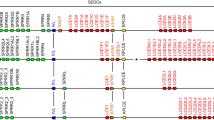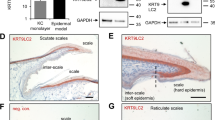Abstract
The mammalian skin and its appendages depend on tightly coordinated differentiation of epithelial cells. Epidermal growth factor receptor (EGFR) pathway substrate 8 (EPS8) like 1 (EPS8L1) is enriched in the epidermis among human tissues and has also been detected in the epidermis of lizards. Here, we show by the analysis of single-cell RNA-sequencing data that EPS8L1 mRNA is co-expressed with filaggrin and loricrin in terminally differentiated human epidermal keratinocytes. Comparative genomics indicated that EPS8L1 is conserved in all main clades of mammals, whereas the orthologous gene has been lost in birds. Using a polyclonal antibody against EPS8L1, we performed an immunohistochemical screening of skin from diverse mammalian species and immuno-electron microscopy of human skin. EPS8L1 was detected predominantly in the granular layer of the epidermis in monotremes, marsupial, and placental mammals. The labeling was partly associated with cell membranes, and it was evident along the perimeter of keratinocytes at the transition with the cornified layer of the epidermis, similar to involucrin distribution. Basal, spinous, and the fully mature cornified layers lacked immunolabeling of EPS8L1. In addition to the epidermis, the hair follicle inner root sheath (IRS) was immunolabeled. Both epidermal granular layer and IRS contribute to the barrier function of the skin, suggesting that EPS8L1 is involved in the regulation of these barriers.









Similar content being viewed by others
References
Alibardi L (2004a) Fine structure and immunocytochemistry of monotreme hairs with emphasis on the inner root sheath and trichohyaline-based cornification during hair evolution. J Morphol 261:345–363
Alibardi L (2004b) Fine structure of marsupial hairs with emphasis on trichohyalin and the structure of the inner root sheath. J Morphol 261:390–402
Alibardi L (2006) Ultrastructure of bat (Pipistrellus kuhlii) epidermis with emphasis on terminal differentiation of corneocytes. Zool Res 27:86–93
Alibardi L (2009) Review: embryonic keratinization in vertebrates in relation to land colonization. Acta Zool (stockolm) 90:1–17
Alibardi L (2010) The ultrastructural immunolocalization of loricrin in the hairy epidermis of the platypus (Ornithorhynchus anatinus, Monotremata) indicates it contributes to the formation of the cell corneous envelope. Belg J Zool 140:59–64
Alibardi L (2012) Ultrastructural pattern of loricrin localization in the epidermis of the red kangaroo Macropus rufus (Marsupialia, Mammalia) in relation to the formation of the stratum corneum in mammalian epidermis. Ital J Zool 79:69–76
Alibardi L (2023) Immunolocalization of Pglyrp3 and Eps8l1 proteins in the regenerating lizard epidermis indicates they contribute to epidermal barrier formation. Zoology 157:126080
Alibardi L, Maderson PFA (2003) Distribution of keratins and associated proteins in the epidermis of monotremes, marsupial and placental mammals. J Morphol 258:49–66
Alibardi L, Dockal M, Reinisch C, Tschachler E, Eckart L (2004) Ultrastructural localization of caspase-14 in human epidermis. J Histochem Cytochem 52:1561–1574
Alibardi L, Tschachler E, Eckhart L (2005) Distribution of caspase-14 in epidermis and hair follicles is evolutionary conserved among mammals. Anat Rec 286A:962–973
Amberg N, Sotiropoulou PA, Heller G, Lichtenberger BM, Holcmann M, Camurdanoglu B, Baykuscheva-Gentscheva T, Blanpain C, Sibilia M (2019) EGFR controls hair shaft differentiation in a p53-independent manner. IScience 15:243–256
Barresi C, Rossiter H, Buchberger M, Pammer J, Sukseree S, Sibilia M, Tschachler E, Eckhart L (2022) Inactivation of autophagy in keratinocytes reduces tumor growth in mouse models of epithelial skin cancer. Cells 11:3691
Eckhart L, Zeeuwen PLJM (2018) The skin barrier: Epidermis vs environment. Exp Dermatol 27:805–806
Eckhart L, Uthman A, Sipos W, Tschachler E (2006) Genome sequence comparison reveals independent inactivation of the caspase-15 gene in different evolutionary lineages of mammals. Mol Biol Evol 23:2081–2089
Eckhart L, Schmidt M, Mildner M, Mlitz V, Abtin A, Ballaun C, Fischer H, Mrass P, Tschachler E (2008) Histidase expression in human epidermal keratinocytes: regulation by differentiation status and all-trans retinoic acid. J Dermatol Sci 50:209–215
Edqvist PH, Fagerberg L, Hallström BM, Danielsson A, Edlund K, Uhlén M, Pontén F (2015) Expression of human skin-specific genes defined by transcriptomics and antibody-based profiling. J Histochem Cytochem 63:129–141
Elias PM, Choi EH (2005) Review. Interactions among stratum corneum defensive functions. Exp Dermatol 14:719–726
Frittoli E, Matteoli G, Palamidessi A, Mazzini E, Maddaluno L, Disanza A, Yang C, Svitkina T, Rescigno M, Scita G (2011) The signaling adaptor Eps8 is an essential actin capping protein for dendritic cell migration. Immunity 35:388–399
Furness DN, Johnson SL, Manor U, Rüttiger L, Tocchetti A, Offenhauser N, Olt J, Goodyear RJ, Vijayakumar S, Dai Y, Hackney CM, Franz C, Di Fiore PP, Masetto S, Jones SM, Knipper M, Holley MC, Richardson GP, Kachar B, Marcotti W (2013) Progressive hearing loss and gradual deterioration of sensory hair bundles in the ears of mice lacking the actin-binding protein Eps8L2. Proc Natl Acad Sci U S A 110:13898–13903
Giampietro C, Disanza A, Bravi L, Barrios-Rodiles M, Corada M, Frittoli E, Savorani C, Lampugnani MG, Boggetti B, Niessen C, Wrana JL, Scita G, Dejana E (2015) The actin-binding protein EPS8 binds VE-cadherin and modulates YAP localization and signaling. J Cell Biol 211:1177–1192
Gorzelanny C, Mess C, Schneider SW, Huck V, Brandner JM (2020) Skin barriers in dermal drug delivery: which barriers have to be overcome and how can we measure them? Pharmaceutics 12:684
Green KJ, Niessen CM, Rübsam M, Perez White BE, Broussard JA (2022) The desmosome-keratin scaffold integrates ErbB family and mechanical signaling to polarize epidermal structure and function. Front Cell Dev Biol 10:903696
Gulati N, Krueger JG, Suárez-Fariñas M, Mitsui H (2013) Creation of differentiation-specific genomic maps of human epidermis through laser capture microdissection. J Invest Dermatol 133:2640–2642
Ishida-Yamamoto A, Takahashi H, Iizuka H (2000) Immunoelectron microscopy links molecules and morphology in the studies of keratinization. Eur J Dermatol 10:429–435
Ishida-Yamamoto A, Igawa S, Kishibe M (2018) Molecular basis of the skin barrier structures revealed by electron microscopy. Exp Dermatol 27:841–846
Kalinin AE, Kajava AV, Steinert PM (2002) Epithelial barrier function: assembly and structural features of the cornified cell envelope. BioEssays 24:789–800
Kalinina P, Vorstandlechner V, Buchberger M, Eckhart L, Lengauer B, Golabi B, Laggner M, Hiess M, Sterniczky B, Födinger D, Petrova E, Elbe-Bürger A, Beer L, Hovnanian A, Tschachler E, Mildner M (2021) The whey acidic protein WFDC12 is specifically expressed in terminally differentiated keratinocytes and regulates epidermal serine protease activity. J Invest Dermatol 141:1198–1206
Karim N, Phinney BS, Salemi M, Wu PW, Naeem M, Rice RH (2019) Human stratum corneum proteomics reveals cross-linking of a broad spectrum of proteins in cornified envelopes. Exp Dermatol 28:618–622
Lanzetti L, Rybin V, Malabarba MG, Christoforidis S, Scita G, Zerial M, Di Fiore PP (2000) The Eps8 protein coordinates EGF receptor signalling through Rac and trafficking through Rab5. Nature 408:374–377
Lichtenberger BM, Gerber PA, Holcmann M, Buhren BA, Amberg N, Smolle V, Schrumpf H, Boelke E, Ansari P, Mackenzie C, Wollenberg A, Kislat A, Fischer JW, Röck K, Harder J, Schröder JM, Homey B, Sibilia M (2013) Epidermal EGFR controls cutaneous host defense and prevents inflammation. Sci Transl Med 5:199ra111
Mathes C, Brandner JM, Laue M, Raesch SS, Hansen S, Failla AV, Vidal S, Moll I, Schaefer UF, Lehr CM (2016) Tight junctions form a barrier in porcine hair follicles. Eur J Cell Biol 95:89–99
Matsui T, Amagai M (2015) Dissecting the formation, structure and barrier function of the stratum corneum. Int Immunol 27:269–280
Matsui T, Kadono-Maekubo N, Suzuki Y, Furuichi Y, Shiraga K, Sasaki H, Ishida A, Takahashi S, Okada T, Toyooka K, Sharif J, Abe T, Kiyonari H, Tominaga M, Miyawaki A, Amagai MA (2021) Unique mode of keratinocyte death requires intracellular acidification. Proc Natl Acad Sci USA 118:e2020722118
Menon GK, Ghadially R, Williams ML, Elias PM (1992) Lamellar bodies as delivery systems of hydrolytic enzymes: implications for normal and abnormal desquamation. Br J Dermatol 126:337–345
Offenhauser N, Borgonovo A, Disanza A, Romano P, Ponzanelli I, Iannolo G, Di Fiore PP, Scita G (2004) The eps8 family of proteins links growth factors stimulation to actin reorganization generating functional redundancy in the Ras/Rac pathway. Mol Biol Cell 15:91–98
Rawlings AV, Scott IR, Harding CR, Bowser PA (1994) Stratum corneum moisturization at the molecular level. J Invest Dermatol 103:731–740
Rice RH, Durbin-Johnson BP, Ishitsuka Y, Salemi M, Phinney BS, Rocke DM, Roop DR (2016) Proteomic analysis of loricrin knockout mouse epidermis. J Proteome Res 15:2560–2566
Rübsam M, Mertz AF, Kubo A, Marg S, Jüngst C, Goranci-Buzhala G, Schauss AC, Horsley V, Dufresne ER, Moser M, Ziegler W, Amagai M, Wickström SA, Niessen CM (2017) E-cadherin integrates mechanotransduction and EGFR signaling to control junctional tissue polarization and tight junction positioning. Nat Commun 8:1250
Sachslehner AP, Surbeck M, Golabi M, Geiselhofer M, Jager K, Hess C, Kuchler U, Gruber R, Eckhart L (2023) Transglutaminase activity is conserved in stratified epithelia and skin appendages of mammals and birds. Int J Mol Sci 24:2193
Scala C, Cenacchi G, Ferrari C, Pasquinelli G, Preda P, Manara G (1992) A new acrylic resin formulation: a useful tool for histological, ultrastructural, and immunocytochemical investigations. J Histochem Cytochem 40:1799–1804
Sokolov VE (1982) Mammalian skin. University of California Press, Berkley-Los Angeles-New York
Sølberg JBK, Quaade AS, Drici L, Sulek K, Ulrich NH, Løvendorf MB, Thyssen JP, Mann M, Dyring-Andersen B, Johansen JD (2023) The proteome of hand eczema assessed by tape stripping. J Invest Dermatol 143:1559–1568
Steven AC, Bisher ME, Roop DR, Steinert PM (1990) Biosynthetic pathways of filaggrin and loricrin-two major proteins expressed by terminally differentiated epidermal keratinocytes. J Struct Biol 104:150–162
Tocchetti A, Confalonieri S, Scita G, Di Fiore PP, Betsholtz C (2003) In silico analysis of the EPS8 gene family: genomic organization, expression profile, and protein structure. Genomics 81:234–244
Warhol MJ, Roth J, Lucocq JM, Pinkus GS, Rice RH (1985) Immuno-ultrastructural localization of involucrin in squamous epithelium and cultured keratinocytes. J Histochem Cytochem 33:141–149
Wu Z, Hansmann B, Meyer-Hoffert U, Gläser R, Schröder JM (2009) Molecular identification and expression analysis of filaggrin-2, a member of the S100 fused-type protein family. PLoS ONE 4:e5227
Zampini V, Rüttiger L, Johnson SL, Franz C, Furness DN, Waldhaus J, Xiong H, Hackney CM, Holley MC, Offenhauser N, Di Fiore PP, Knipper M, Masetto S, Marcotti W (2011) Eps8 regulates hair bundle length and functional maturation of mammalian auditory hair cells. PLoS Biol 9:e1001048
Zhang X, Guo BR, Cai LQ, Jiang T, Sun LD, Cui Y, Hu JC, Zhu J, Chen G, Tang XF, Sun GQ, Tang HY, Liu Y, Li M, Li QB, Cheng H, Gao M, Li P, Yang X, Zuo XB, Zheng XD, Wang PG, Wang J, Wang J, Liu JJ, Yang S, Li YR, Zhang XJ (2012) Exome sequencing identified a missense mutation of EPS8L3 in Marie Unna hereditary hypotrichosis. J Med Genet 12:727–730
Acknowledgements
We thank Maria Buchberger, Bahar Golabi, Dragan Copic, and Erwin Tschachler (Medical University of Vienna) for helpful discussions. The study was partly self-supported (LA). This paper is dedicated to my (LA) beloved father-in law, Bruno, who was the closer oldest friend that I ever had.
Author information
Authors and Affiliations
Corresponding author
Ethics declarations
Competing Interests
The authors declare no competing interests in the present manuscript.
Additional information
Handling Editor: Reimer Stick
Publisher's Note
Springer Nature remains neutral with regard to jurisdictional claims in published maps and institutional affiliations.
Rights and permissions
Springer Nature or its licensor (e.g. a society or other partner) holds exclusive rights to this article under a publishing agreement with the author(s) or other rightsholder(s); author self-archiving of the accepted manuscript version of this article is solely governed by the terms of such publishing agreement and applicable law.
About this article
Cite this article
Alibardi, L., Surbek, M. & Eckhart, L. Comparative immunohistochemical analysis suggests a conserved role of EPS8L1 in epidermal and hair follicle barriers of mammals. Protoplasma 261, 333–349 (2024). https://doi.org/10.1007/s00709-023-01898-8
Received:
Accepted:
Published:
Issue Date:
DOI: https://doi.org/10.1007/s00709-023-01898-8




